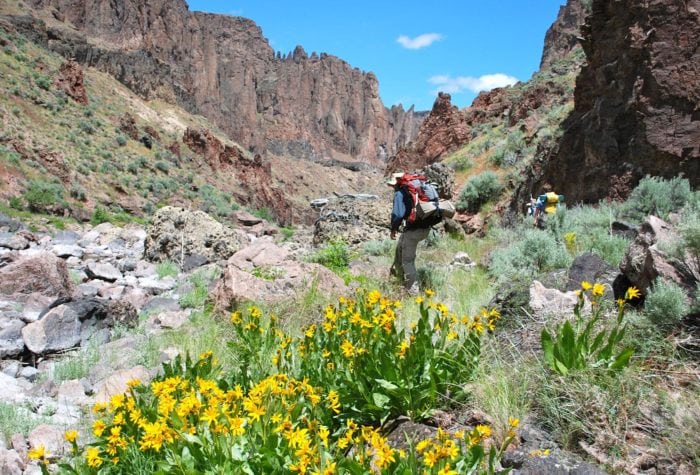Following these suggestions will help you travel safely through the high desert of eastern Oregon and enjoy fragile places responsibly.
Desert Safety:
- Drink plenty of water. Eastern Oregon is arid, and you may need to carry more water than you are used to in other environments. Be conservative and carry more than you need until you have a good handle on your body’s needs in this environment. If you are going on a multi-day trip, carry an adequate water purification system and consume plenty of electrolytes (the salts and sugars your body needs to help you absorb the water you are drinking).
- Seek out shade, or carry it with you. Make use of shade for food and water breaks. And, with little to no shade throughout much the desert, consider carrying a sun umbrella to take your shade along with you.
- Cover up. Desert sun can be harsh on a hiker’s skin, so consider covering up with lightweight long sleeves and pants for sun protection.
- Be prepared for temperature swings -Days are hot and nights are cool – even on the hottest days in the desert, the temperatures can drop dramatically when the sun sets. Be prepared for cooler temperatures at night.
- Be mindful in brushy sections. Use a hiking pole or stick to rustle tall grasses as you hike to help alert any snakes, and other wildlife, to your presence and give both of you a chance to move away from an encounter. Wearing tall gaiters can be useful in cross-country sections with heavy vegetation, or in places with difficult bushwhacks, to protect your ankles from both snakes and thorny brush.
- Go easy during the hottest part of the year, or time of the day. Be careful that you don’t plan to engage in strenuous activities during the hottest part of the year, or during the heat of the day. Hiking during the spring or fall can provide more comfortable all-around temperatures for hiking, or, if you’re going mid-summer, consider getting up early or hiking late and being more relaxed at midday. Think siesta!
- Use Verizon cell service. Verizon has the best cell service throughout the high desert. The exception is in the Owyhee region where there is little to no service at all.
- Consider carrying a personal locator beacon. Technology has advanced to the point that hikers can always seek assistance if needed with the use of personal locator beacons.
- Watch your steps and avoid damaging sensitive terrain. Many areas in the high desert are best explored off trail. To minimize impacts of travel through fragile high desert soils, if you see other footprints, don’t follow them. Instead choose a similar bearing and walk a short distance away. Desert soils can be easily impacted, and it only takes a few hikers to start establishing tread in the desert. Be particularly careful not to step on black, knobby crusts on the soil or sand. These cryptobiotic soil crusts perform important ecological roles, including carbon fixation and more, and can be damaged easily.
- Cross fences carefully. Hikers may encounter fences on cross-country hikes in the high desert, and yes, fences are on public lands. Because many of the high desert landscapes are used for grazing and ranching, these fences keep the cattle where they belong. Cross these fences with care. If you encounter gates, leave them as you find them. Please respect the multiple other uses throughout in the desert.
- Avoid driving on wet roads. Waterlogged desert soils can bog down a vehicle in inches or feet of mud. In remote parts of the Oregon Desert, recent precipitation can make some roads impassable, even on flat terrain. Gravel roads can be a better bet when conditions are wet as the gravel can provide extra traction between your car tires and the slick mud. Remember that help in the form of a tow-truck can be hours to days away, and prohibitively expensive in these remote locations.
- Don’t start a sagebrush wildfire. All motorists should have required fire prevention equipment in their vehicle to ensure fire prevention and personal safety. With the exception of traveling on state and county roads, you are required to have: an axe, a shovel, and one gallon of water and/or one 2.5 pound or larger fire extinguisher. Open fires, including campfires, charcoal fires, cooking fires and warming fires, are permitted only at posted and designated sites, and, smoking in wildland areas is permitted only in enclosed vehicles on roads. Know what is required by the BLM.
